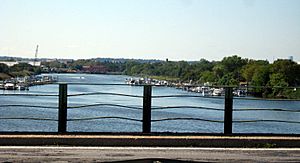Paerdegat Basin facts for kids
The Paerdegat Basin is a water channel in southeast Brooklyn, New York, United States. It connects to Jamaica Bay in the south. The basin is located between the neighborhoods of Bergen Beach and Canarsie. Its name, "Paerdegat," comes from an old Dutch word meaning "horse gate."
Contents
How Paerdegat Basin Was Formed
The Paerdegat Basin you see today was created in the late 1920s. Before that, it was a natural creek fed by fresh water. This creek was known by different names, like Bestevaar Kill and Bedford Creek. It was much longer and had many branches. The area next to the creek also had Brooklyn's last natural forest, which was removed in 1940.
Plans for a Big Seaport
For a while, there was a big idea to turn Jamaica Bay into a major shipping port. This new port would have been an alternative to the busy New York Harbor. This plan was first thought about in the 1910s but didn't happen.
Bringing Back the Seaport Idea
In 1927, the idea of a port was brought up again. Planners wanted to build new railroad lines to connect the port to the Long Island Rail Road. They hoped to link Staten Island through a planned tunnel. This would allow goods to be shipped across the country. The Port Authority of New York and New Jersey even offered to build the new railroad link.
What Happened to the Plans?
In 1931, the New York City Board of Estimate approved building railroads on both sides of Paerdegat Basin. These lines would connect to Canarsie Pier and Floyd Bennett Field. However, most of these big plans for rail service never came true.
The only part of the plan that was finished was making Paerdegat Basin deeper. It was dredged to a depth of about 16 feet (4.9 meters). Later, in the 1950s and 1960s, much of the land around the basin was sold. New neighborhoods like Georgetown and Bergen Beach were built there.
Cleaning Up the Waterway
The Paerdegat Basin has faced pollution problems. This is because of something called a combined sewer system. This system carries both wastewater from homes and factories, and rainwater from storms. Normally, all this water goes to the Coney Island Wastewater Treatment Plant.
Dealing with Heavy Rain
During heavy rain, the treatment plant can't handle all the water. When this happens, untreated water can flow into Paerdegat Basin. The New York City Department of Environmental Protection (DEP) is working to fix this problem. They want to protect the environment and the animals that live in the basin.
Building a Holding Tank
The DEP and the Parks Department have built a special facility called a Combined Sewer Overflow (CSO) facility. This facility acts like a giant holding tank for the extra water during storms. Once the Knapp Street plant can take more water, the water from the holding tank is pumped back to the plant. This stops raw, untreated sewage from flowing into the basin. The CSO facility was finished in August 2011.


